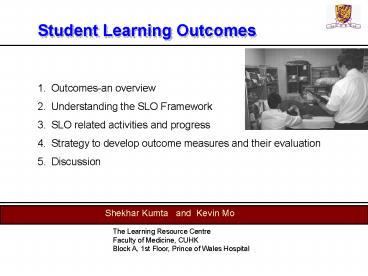Teaching and Learning - PowerPoint PPT Presentation
1 / 23
Title:
Teaching and Learning
Description:
... and posterior borders, pedicles and spinous processes on a plain radiograph ... must be able to interpret radiographs of the long bones, hip knee shoulder wrist ... – PowerPoint PPT presentation
Number of Views:27
Avg rating:3.0/5.0
Title: Teaching and Learning
1
Student Learning Outcomes
- Outcomes-an overview
- Understanding the SLO Framework
- SLO related activities and progress
- Strategy to develop outcome measures and their
evaluation - Discussion
Shekhar Kumta and Kevin Mo
The Learning Resource Centre Faculty of
Medicine, CUHK Block A, 1st Floor, Prince of
Wales Hospital
2
Educational Environment
Faculty and Curriculum
Adapted from AMEE Education Guide 14. Outcome
Based Education
3
What are Learning Outcomes Statements of the
knowledge, skills, and attitudes the
individual student possesses and can demonstrate
upon completion of a learning experience or
sequence of learning experiences (e.g., course,
program, degree).
4
Learning Outcomes
What the student is able to do Can be
assessed Measured
5
SMART
Objectives and Outcomes
Students are expected to examine the cervical
thoracic and lumbar spine
Given a patient complaining of back and neck pain
- To the extent that they can
- Locate the site of pain
- Identify muscle spasm and guarding
Year-3 students
6
(No Transcript)
7
Competence in Musculoskeletal Examination
Identify 5 degree loss of movement Grade II
or more
8
Objectives and Outcomes
Exit Outcomes
Phase Outcomes
Course
Lesson
9
Nesting of Outcomes
To the extent that they can identify vertebral
end-plates, anterior and posterior borders,
pedicles and spinous processes on a plain
radiograph
Students are expected to know the gross and cross
sectional anatomy of a typical spinal-vertebral
segment
Are able to identify patterns of neurological
injury (Brown-Sequard, Central Cord Syndrome), in
SCI patients
10
McNeir 1993
The key for most schools is in developing
outcomes that are broad in their vision but
specific enough to be taught and measured
effectively
Prideaux 2000
We must guard against the narrow specification of
outcomes
Outcomes that are hard to measure but
educationally and professionally significant
should not be omitted because of their
imprecision Creativity judgement and
responsibility
McNeir 1993- Outcome Based Education Tools for
restructuring. David Prideaux 2000,Medical
Education 34 168-169.
11
SLO Framework
The UG curriculum is built upon an integrated and
cohesive structure through contributions each
discipline makes to the outcomes Yet, Outcomes
may be exhibited in different ways in each
specialty
12
The Scottish Doctor--- SLO initiative
13
Progress to date
14
Outcomes
Teaching
- Developing Outcomes
- The ORT Experience
Assessment
- ORT Curricular Handbook as a reference
- Teaching interventions - teacher survey
- Description of teaching intervention
- Learning outcomes expected
- Methods to assess them if any
- Define outcome measures
- Map Outcomes to SLO Framework
25 ORT Teaching Interventions 60 of Year-3
Teachers responded
Acknowledgements Prof Margaret Wong, Dr. TP Lam,
Sally and Horace Ma
15
A scheme to facilitate SLO development
- I Generalised Student Learning Outcomes
- II Outcomes for Specific Subjects/Topics
- Theory of Knowledge
- History taking skills
- Physical examination
- Interpretation of Investigations
Anatomy Biomechanics Pathophysiology and
epidemiology
Radiologic Biochemical/Haematological
16
Radiographic Investigations
PI-D3 Patient Investigations PII-D8 Underlying
principles (structure)
- To the degree that they can identify
- Radiographic projection
- Key skeletal landmarks
- Angular Deformity gt100
- Direction of fracture displacement
- Identify articulating components
- Loss of articular congruity
17
25 ORT Teaching Interventions Mapped to SLO
Framework
- Pillar I What the doctor is able to do
- Clinical Skills 22
- Practical Procedures -
- Patient Investigations 2
- Patient Management 10
- Health Promotion -
- Communication 6
- Medical Informatics -
- Pillar II How the doctor approaches his practice
- Basic Social and Clinical Sciences 6
- Attitudes, Ethical Understanding -
- Decision Making Skills -
- Pillar III The doctor as a professional
- Personal Development 1
- The Role of the Doctor within the health service
- -
18
(No Transcript)
19
SLO Task Force Strategy
20
Questions the UGC is likely to ask
Teachers
Are teachers familiar with specified outcomes
? Have teachers a detailed understanding of the
educational outcomes and their own contribution
to the curriculum ? Does their contribution to
the programme reflect this understanding ? Do the
assessment procedures adopted assess outcomes ?
21
Questions the UGC is likely to ask
Students
Are students familiar with the outcomes expected
? Do they find the outcomes helpful as guides to
learning ? Do they perceive the learning
experience provided and the assessment procedures
reflect the outcomes ?
22
Student Learning Outcomes
Outcomes reflect the Visions and expectations
teachers have of their students
Your contribution is vital
23
OrthopaediX
Student ..Sir, There is a 4 cm shortening of
the left lower limb..
Surgeon And how short is the Right side ?......































